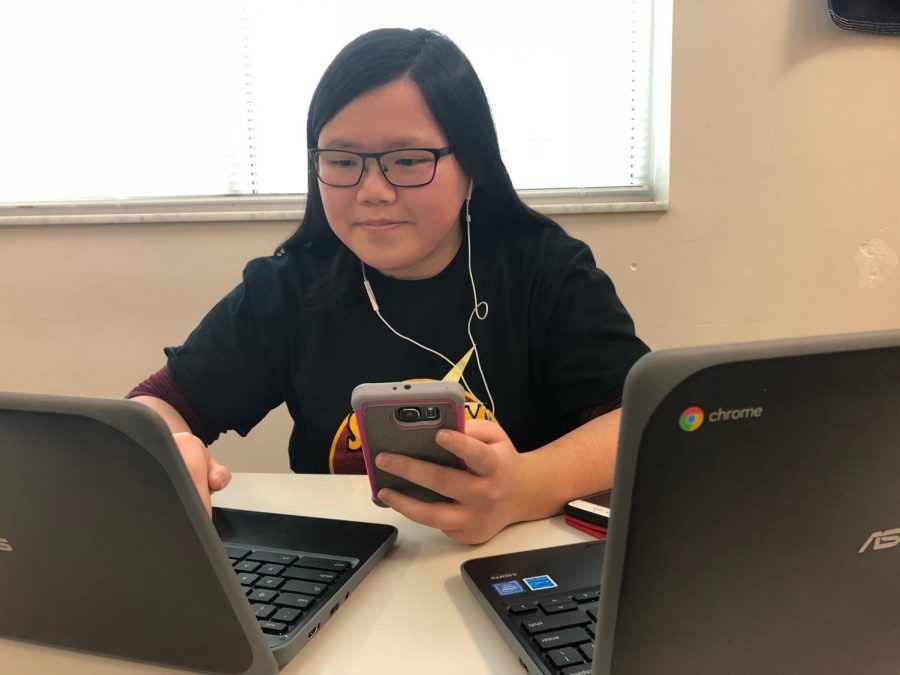Teens and technology today
On Jan. 15, Maya Peterson-Womack works on her Chromebook while also on her phone. Peterson-Womack belives that today her and other teens are increasingly using technology. Peterson-Womack says one way she tries to limit her technology use is by studying “old-school” ways with paper and pencil.
January 18, 2018
There are just 86,400 seconds in a day. Within those seconds, there are countless things that can be accomplished. However, in a research study done by The Common Sense Census, it was concluded that American teenagers use an average of 9 hours of media daily, not including use for school or homework. Those hours alone take up 32,400 seconds of each days 86,400 seconds. That’s nearly 38 percent of a teenagers’s day spent using technology.
Today, the world is more connected than it’s ever been. Any information someone could want is at their fingertips. These advances in technology have given the normal person a window into the wider world. But, as technology becomes more and more available, it is being given to children and teenagers at continually younger ages. Recently, two shareholders for Apple Inc, Jana Partners and the California State Teachers’ Retirement System, urged the technology corporation to take steps that address what they call a growing problem of young people getting addicted to their phones. This has brought the issue of ‘phone addiction’ into the public’s eye once again.
Daniel Jones, a psychology teacher at SHS, often has lesson that coincide with these ways of thinking.
“Technology can be harmful,” Jones said. “You have to go back to the basic chemical components. The whole conversations has to centralize around the addiction.”
As Jones explains in his psychology class, whenever someone receives a text, or gets a like on a post, or is added by a new friend, a bit of the neurotransmitter dopamine is released. Dopamine plays a major role in reward-motivated behavior, meaning most rewards increase dopamine in the brain, making you feel happy. Dopamine levels can be increased by many addictive drugs, including cocaine. This hit of dopamine that comes about from the use of social media can encourage users to use social platforms more and more, becoming focused on just getting more dopamine rewards.
However, the possibility of social media addiction is not the only problem Jones has with social media. He finds more fault in the depersonalizing of communications.
“Where I see social media becoming a problem is in the ostracism people experience there. We are social beings, we are hired to be social, we receive value from meaningful relationships with one another,” Jones said. “I think there’s value in having a conversation with someone and looking them in the eye.”
Maya Peterson-Womack, a senior who takes Jones’ AP psychology class, agrees with Jones. Peterson-Womack sees a problem in how often she and her peers are on their phones, and how that takes away from real social connections. She believes that technology on the whole has improved lives, by making everyday life so convenient and entertaining. However, she believes there is such a thing as too much, and that cell phone users need to decide when their tech is needed.
She also finds fault in how it exposes people, especially young kids, to the harsher side of the world.
“It introduces people to the reality of the world much earlier than how it used to be,” Peterson-Womack said. “Now there’s little kids on phones, seeing things they shouldn’t.”
Despite the problems technology might cause, both Jones and Peterson-Womack believe people can counteract the negative side effects by examining their personal use of the cell phone and social media. They emphasize the importance of self-discipline and self-awareness when it comes to technology.
Peterson-Womack says that the use of ‘old-school’ styles of studying, such as writing everything down instead of typing it, can help her focus and gets her away from technology in a good way. Jones believes in putting away all technology and allowing for oneself to be alone with their thoughts. This, he says, allows for more creative thinking and innovation.
Jones says that the most important thing people can do to counteract the negative impact of technology is to educate themselves and others on the possible effects of using it. People, especially teenagers, need to be exposed to the type of cell phone use that is irresponsible, to allow themselves to evaluate the way they use technology in their life.
“At the very least, everybody using social media has to think about, ‘how is this making the world a better place?’” Jones said. “And I know that sounds like the most cliche thing in the world, but isn’t that what we’re here to do?”



